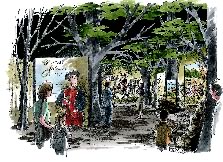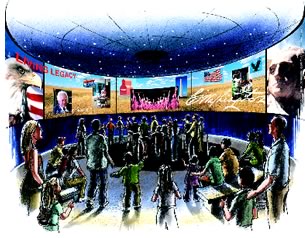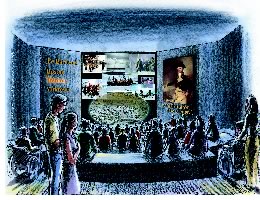

07/2004
New Buildings to Help Introduce the Real George Washington
Supporters of George Washington’s Mount Vernon estate and gardens used golden shovels June 18 to break ground for new, state-of-the-art visitor orientation, education, and museum buildings designed by GWWO Inc./Architects, Baltimore. The buildings are the major components of an $85 million “To Keep Him First” program to reintroduce George Washington to the American public.
 Ground-breaking
ceremonies included planting a massive red maple, the first of 200 well-developed
trees—representing 27 different species George Washington grew at
Mount Vernon—destined for the grounds of the estate. The trees,
in two locations to the northwest of the house, will help screen the new
facilities from view from the historic area. The buildings—the Ford
Orientation Center and Donald W. Reynolds Museum and Education Center—will
be completed by the end of 2006.
Ground-breaking
ceremonies included planting a massive red maple, the first of 200 well-developed
trees—representing 27 different species George Washington grew at
Mount Vernon—destined for the grounds of the estate. The trees,
in two locations to the northwest of the house, will help screen the new
facilities from view from the historic area. The buildings—the Ford
Orientation Center and Donald W. Reynolds Museum and Education Center—will
be completed by the end of 2006.
Respectful design and landscaping
To ensure that the museum and education center did not detract from the
historic mansion, GWWO designed 65 percent of the 66,700-square-foot complex
to be under the four-acre pasture just inside Mount Vernon’s main
gate. The pastoral setting and viewsheds to and from the mansion will
be preserved, and Hogg Island sheep, like those Washington raised 200
years ago, will graze in the pasture. Serving as the only presidential
library for Washington, the museum and education center will also be America’s
only presidential library with grass for a roof.
 “Despite
its significant size, the complex will nestle into the landscape, and
visitors will not be aware of the scale of the building,” said GWWO
Principal Alan Reed, AIA. “Moreover, the infusion of natural light
into the lobby and main circulation corridors at all levels will ease
the transition to the lower level, and visitors most likely never will
realize they are underground.”
“Despite
its significant size, the complex will nestle into the landscape, and
visitors will not be aware of the scale of the building,” said GWWO
Principal Alan Reed, AIA. “Moreover, the infusion of natural light
into the lobby and main circulation corridors at all levels will ease
the transition to the lower level, and visitors most likely never will
realize they are underground.”
Landscape architect Roger Courtenay, principal of EDAW Inc., Alexandria, Va., worked closely with the GWWO team throughout the design process to ensure that the architecture and landscape enhance each other in much the same way as did Washington’s original house and garden designs.
Ford Orientation Center
Located just inside the historic Texas Gate, the main entrance to Mount
Vernon, the Ford Orientation Center (named after the Ford Motor Company,
its major benefactor) will introduce visitors to the personality and character
of George Washington “as his contemporaries knew him.” The
Mount Vernon Estate reports that “the center will dispel the traditional
image of the stern-faced old man on the dollar bill and reveal the true
George Washington, a charismatic hero, visionary, and entrepreneur who
overcame childhood adversities and lack of formal education to lead an
ill-trained army into victory against the mighty British empire, hold
a struggling infant nation together, and lay the groundwork for a free
and prosperous America.”
 The
lobby of the new center will feature an elliptical floor-to-ceiling glass
wall with views to the pasture beyond. The light-filled space will give
visitors a continuous visual connection to the estate. Visitors also will
be able to enjoy the lobby’s stained-glass window depicting five
critical scenes from Washington’s life. Below the c. 1950s-1960s
stained glass panels will be a timeline of his 67 years.
The
lobby of the new center will feature an elliptical floor-to-ceiling glass
wall with views to the pasture beyond. The light-filled space will give
visitors a continuous visual connection to the estate. Visitors also will
be able to enjoy the lobby’s stained-glass window depicting five
critical scenes from Washington’s life. Below the c. 1950s-1960s
stained glass panels will be a timeline of his 67 years.
The center will use two adjacent theaters seating a total of 450 people to show a large-format, 15-minute film providing insight into the story of Washington’s life. It also will house “Mount Vernon in Miniature,” an authentic, one-twelfth-scale version of the mansion that has been touring the U.S. since its 1999 debut. The $500,000 model was created over a period of five years by miniaturists, artisans, and Washington enthusiasts. Two of its walls raise and lower mechanically, and the roof opens to reveal the beautifully furnished 22-room house, with its finely detailed woodwork and reproductions of Washington’s furniture, china, paintings, and books. The curators report that a single mouse whisker was used to hand-paint some details on porcelain and lacquer ware pieces.
 As
Washington’s presidential library the center will offer anyone anywhere
in the world online access to all of Washington’s papers and 40,000
letters via its Web site. Mount
Vernon is currently raising money to have the letters digitized by the
University of Virginia and the Library of Congress. Visiting scholars
will have access to its entire collection of official papers, personal
letters, and many of Washington’s 900 books.
As
Washington’s presidential library the center will offer anyone anywhere
in the world online access to all of Washington’s papers and 40,000
letters via its Web site. Mount
Vernon is currently raising money to have the letters digitized by the
University of Virginia and the Library of Congress. Visiting scholars
will have access to its entire collection of official papers, personal
letters, and many of Washington’s 900 books.
Donald W. Reynolds Museum and Education
Center
The Donald W. Reynolds Museum and Education Center features 23 galleries
and “theater experiences” that stress the importance of Washington’s
military and presidential careers as well as events not covered by the
usual Mount Vernon tour. Constructed primarily underground, the museum
and education center employs computer imaging, LED map displays, dynamic
graphics, surround-sound audio programs, “immersion” videos,
illusionist lighting effects, dramatic staging, and touch-screen computer
monitors. The center’s Revolutionary War Theater will offer a 12-minute
multimedia presentation showcasing Washington’s role in three major
battles, in Boston, Trenton, and Yorktown, and provide viewers the ultimate
in theatrical entertainment: snow, rumble seats, and fog.
 The
gallery entitled “A Leader’s Smile,” will display Washington’s
famous mechanically hinged dentures, which were made of human teeth, cow
teeth, and elephant ivory; not wood, contrary to popular belief. “Once
you see these very uncomfortable false teeth, you understand why Washington
looked so pained in so many of his portraits,” said Jim Rees, Mount
Vernon’s executive director. In another gallery, visitors will walk
through a wooded set, hearing bullets, cannons, and other sounds of war,
before reaching Fort Necessity. Nine videos on Washington’s accomplishments
as a farmer, inventor, architect, and entrepreneurial businessman, produced
by The History Channel, tell other stories of his remarkable life. The
museum also will feature Washington’s treasures, from his ceremonial
state sword to Rembrandt Peale’s “porthole” portraits
of George and Martha Washington.
The
gallery entitled “A Leader’s Smile,” will display Washington’s
famous mechanically hinged dentures, which were made of human teeth, cow
teeth, and elephant ivory; not wood, contrary to popular belief. “Once
you see these very uncomfortable false teeth, you understand why Washington
looked so pained in so many of his portraits,” said Jim Rees, Mount
Vernon’s executive director. In another gallery, visitors will walk
through a wooded set, hearing bullets, cannons, and other sounds of war,
before reaching Fort Necessity. Nine videos on Washington’s accomplishments
as a farmer, inventor, architect, and entrepreneurial businessman, produced
by The History Channel, tell other stories of his remarkable life. The
museum also will feature Washington’s treasures, from his ceremonial
state sword to Rembrandt Peale’s “porthole” portraits
of George and Martha Washington.
 Another
important feature of the museum will be an authentic crime scene investigation
laboratory using the latest forensic techniques to transform Washington
graphically from an older adult into a vigorous, youthful frontiersman.
The museum also will display three life-size, authentically attired figures
of Washington as he probably looked as a 19-year-old surveyor, 45-year-old
commander-in-chief of the Continental Army, and 57-year-old president.
A team that includes a forensic scientist, computer 3-D modeling group,
plastic surgeon, portrait expert, and craftsmen will create and clothe
the images.
Another
important feature of the museum will be an authentic crime scene investigation
laboratory using the latest forensic techniques to transform Washington
graphically from an older adult into a vigorous, youthful frontiersman.
The museum also will display three life-size, authentically attired figures
of Washington as he probably looked as a 19-year-old surveyor, 45-year-old
commander-in-chief of the Continental Army, and 57-year-old president.
A team that includes a forensic scientist, computer 3-D modeling group,
plastic surgeon, portrait expert, and craftsmen will create and clothe
the images.
Copyright 2004 The American Institute of Architects.
All rights reserved. Home Page ![]()
![]()
 |
||
| Visit Mount
Vernon’s Web site to learn more about the project. Photos courtesy of the Mount Vernon Ladies’ Association.
|
||